|
The highest denomination note of the Philippine Peso is only 1,000, worth about US $20. And even these are in woefully short supply. Therefore, substantial cash transactions inevitably involve large bundles of 500 peso notes, which are widely circulated. For a payment of just 30,000 pesos - 600 dollars - participants will sit around for minutes, counting and recounting money. Don't make the mistake of buying a car or a house in cash!
The difficulty of counting money is exarcebated by the fact that 1000 and 500 peso notes are counterfeited - almost every shop proudly displays a counterfeit note someone tried to pass off as the real thing.
If you plan to do business or live locally, it would be a good idea to get a checking account at a local bank, or one of those cash counting machines banks use. They are available at the National Bookstore stationery store (Ayala; SM; Mango Square) and cost about 9,000 pesos.
200's are still exceedingly rare.
It is terribly difficult to use the 1000 peso notes outside the malls; since most transactions are small, local shopkeepers often have insufficient change. If you plan to ride cabs be sure to have a supply of 100's. If you plan to ride jeeps, you need to carry a supply of coins or small bills - 20's or 50's - around. You have to learn how to hoard your lower-value bills. When paying, hide your bills of lower denomination, or the eagle-eyed cashier may request that you use them. Cashiers are constantly asking whether the customer has 50 cents, one peso, two pesos, three pesos, or five pesos. The correct response is: "Wala!"
|
|
| ____ |
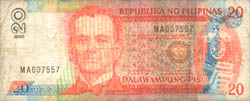
20. MANUEL L. QUEZON

50. SERGIO OSMEA
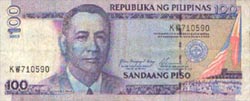
100. MANUEL A. ROXAS
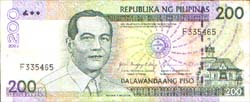
200. DIOSDADO P. MACAPAGAL
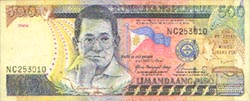
500. BENIGNO AQUINO JR.
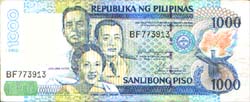
1000. JOSE ABAD SANTOS, VICENTE LIM, JOSEFA LLANES ESCODA
|
|


